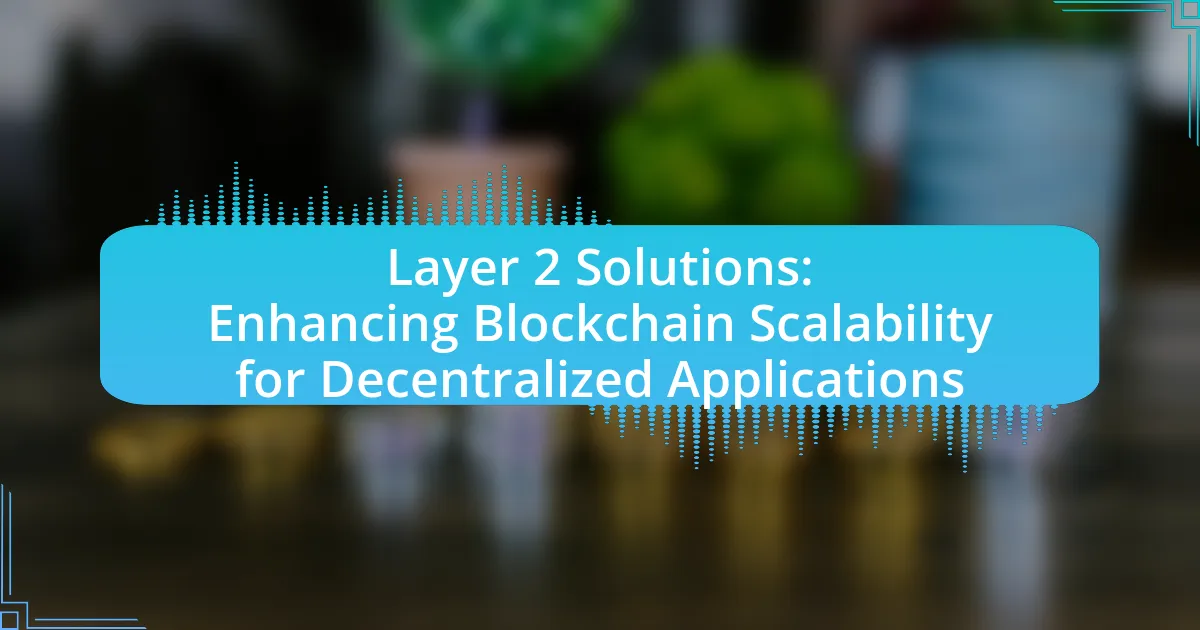The article focuses on future trends in blockchain scalability, highlighting key innovations such as Layer 2 solutions, sharding, and interoperability protocols. It defines blockchain scalability as the ability to efficiently handle increasing transaction volumes and discusses the challenges currently faced, including limited throughput and high latency. The article also explores the implications of scalability on transaction speed and cost, user experience, and network security, while examining the role of emerging technologies like artificial intelligence and quantum computing in enhancing scalability. Additionally, it outlines practical strategies for businesses and developers to prepare for and implement scalable blockchain solutions in the coming decade.

What are the Future Trends in Blockchain Scalability?
Future trends in blockchain scalability include the adoption of Layer 2 solutions, sharding, and interoperability protocols. Layer 2 solutions, such as the Lightning Network for Bitcoin and Optimistic Rollups for Ethereum, aim to increase transaction throughput by processing transactions off the main blockchain while maintaining security. Sharding, which divides the blockchain into smaller, manageable pieces, allows for parallel processing of transactions, significantly enhancing scalability. Interoperability protocols, like Polkadot and Cosmos, facilitate communication between different blockchains, enabling a more scalable and interconnected ecosystem. These trends are supported by ongoing research and development in the blockchain space, indicating a strong focus on overcoming current scalability challenges.
How is blockchain scalability defined in the context of future developments?
Blockchain scalability is defined as the capability of a blockchain network to handle an increasing number of transactions efficiently as it grows. Future developments in blockchain scalability focus on enhancing throughput, reducing latency, and improving overall network performance through innovations such as sharding, layer-2 solutions, and consensus algorithm improvements. For instance, Ethereum 2.0 aims to implement sharding to increase transaction capacity significantly, potentially allowing thousands of transactions per second, which is a substantial improvement over its current limitations.
What are the key challenges currently facing blockchain scalability?
The key challenges currently facing blockchain scalability include limited transaction throughput, high latency, and increased costs associated with network congestion. Limited transaction throughput is evident in major blockchains like Bitcoin and Ethereum, which can process only a fraction of transactions per second compared to traditional payment systems; for instance, Bitcoin handles approximately 7 transactions per second, while Visa can process over 24,000. High latency arises from the time taken to confirm transactions, which can lead to delays in user experience, particularly during peak usage times. Additionally, increased costs due to network congestion can make transactions prohibitively expensive, as seen in Ethereum’s gas fees, which have spiked to hundreds of dollars during high demand periods. These challenges hinder the widespread adoption of blockchain technology for large-scale applications.
How do scalability issues impact blockchain adoption?
Scalability issues significantly hinder blockchain adoption by limiting transaction throughput and increasing latency. For instance, Bitcoin can process only about seven transactions per second, while Ethereum handles approximately 30, which is insufficient for mainstream applications that require high-speed transactions. This limitation leads to higher transaction fees and slower confirmation times during peak usage, discouraging users and businesses from adopting blockchain technology. Furthermore, studies indicate that scalability challenges can result in network congestion, which undermines the reliability and efficiency of blockchain systems, ultimately stalling their integration into various industries.
What innovations are expected to enhance blockchain scalability in the next decade?
Innovations expected to enhance blockchain scalability in the next decade include sharding, layer-2 solutions, and consensus algorithm improvements. Sharding divides the blockchain into smaller, manageable pieces, allowing for parallel processing of transactions, which significantly increases throughput. Layer-2 solutions, such as the Lightning Network for Bitcoin and Optimistic Rollups for Ethereum, enable off-chain transactions that reduce the load on the main blockchain, thereby enhancing scalability. Additionally, advancements in consensus algorithms, like Proof of Stake and its variants, are designed to improve transaction speeds and energy efficiency, further supporting scalability. These innovations are being actively researched and implemented, as evidenced by ongoing developments in major blockchain platforms.
What role do Layer 2 solutions play in improving scalability?
Layer 2 solutions significantly enhance scalability by enabling faster and cheaper transactions while reducing the load on the main blockchain network. These solutions, such as state channels and rollups, process transactions off-chain and only settle final states on the main chain, which alleviates congestion and increases throughput. For instance, Ethereum’s rollups can increase transaction capacity by up to 100 times compared to the base layer, demonstrating their effectiveness in improving scalability.
How might sharding transform blockchain scalability?
Sharding can significantly enhance blockchain scalability by dividing the network into smaller, manageable pieces called shards, allowing multiple transactions to be processed simultaneously. This parallel processing reduces congestion and increases throughput, enabling blockchains to handle a higher volume of transactions per second. For instance, Ethereum 2.0 plans to implement sharding, which is expected to increase its transaction capacity from approximately 30 transactions per second to potentially thousands, thereby addressing scalability issues that have hindered its performance.
Why is scalability crucial for the future of blockchain technology?
Scalability is crucial for the future of blockchain technology because it directly impacts the network’s ability to handle an increasing number of transactions efficiently. As blockchain applications expand, particularly in sectors like finance and supply chain, the demand for high throughput and low latency grows. For instance, Bitcoin processes approximately 7 transactions per second, while Visa can handle over 24,000 transactions per second. This stark difference highlights the necessity for blockchain systems to evolve and implement scalable solutions, such as sharding or layer-2 protocols, to remain competitive and meet user expectations. Without scalability, blockchain technology risks becoming obsolete as it cannot support widespread adoption and real-time applications.
What implications does scalability have for transaction speed and cost?
Scalability directly impacts transaction speed and cost by determining how many transactions a blockchain can process simultaneously. Higher scalability typically leads to faster transaction speeds, as more transactions can be handled in parallel, reducing congestion. For instance, Ethereum’s transition to a proof-of-stake model aims to increase its scalability, potentially allowing thousands of transactions per second compared to its previous capacity of around 30 transactions per second. This increase in speed can lower transaction costs, as users face less competition for block space, which often drives fees up during peak times. Conversely, limited scalability can result in slower transaction speeds and higher costs, as seen during periods of high demand on networks like Bitcoin, where transaction fees surged to over $60 in 2021 due to congestion. Thus, scalability is crucial for enhancing both transaction speed and cost efficiency in blockchain systems.
How does scalability affect user experience and network security?
Scalability directly impacts user experience and network security by determining how well a system can handle increased loads while maintaining performance and security standards. When a blockchain network scales effectively, it can accommodate more transactions per second, leading to faster processing times and improved user satisfaction. For instance, Ethereum’s transition to a proof-of-stake model aims to enhance scalability, which is expected to reduce transaction fees and waiting times, thus enhancing user experience.
Conversely, inadequate scalability can lead to network congestion, resulting in slower transaction speeds and higher fees, which negatively affect user experience. Additionally, scalability challenges can compromise network security; for example, during periods of high demand, a network may become more vulnerable to attacks, such as denial-of-service attacks, as seen in the Bitcoin network during peak usage times. Therefore, effective scalability is crucial for ensuring both a positive user experience and robust network security.

What are the Emerging Technologies Influencing Blockchain Scalability?
Emerging technologies influencing blockchain scalability include sharding, layer 2 solutions, and consensus algorithm improvements. Sharding divides the blockchain into smaller, manageable pieces, allowing for parallel processing of transactions, which significantly enhances throughput. Layer 2 solutions, such as the Lightning Network for Bitcoin and Plasma for Ethereum, enable off-chain transactions that reduce congestion on the main blockchain, thereby increasing transaction speed and lowering costs. Additionally, advancements in consensus algorithms, like Proof of Stake and Delegated Proof of Stake, improve transaction validation efficiency and energy consumption, further supporting scalability. These technologies are critical as they address the limitations of current blockchain infrastructures, enabling broader adoption and functionality.
How will artificial intelligence contribute to blockchain scalability?
Artificial intelligence will enhance blockchain scalability by optimizing transaction processing and improving consensus mechanisms. AI algorithms can analyze transaction patterns and predict network congestion, allowing for dynamic resource allocation and load balancing. For instance, AI can facilitate the development of more efficient consensus protocols, such as delegated proof-of-stake, which can significantly reduce the time and energy required for transaction validation. Research indicates that integrating AI with blockchain can lead to a 50% increase in transaction throughput, as demonstrated in studies by the Massachusetts Institute of Technology, which highlight the potential for AI to streamline operations and enhance overall network efficiency.
What specific AI applications can optimize blockchain networks?
AI applications that can optimize blockchain networks include predictive analytics, smart contract automation, and fraud detection systems. Predictive analytics utilizes machine learning algorithms to forecast network congestion and transaction delays, enabling proactive resource allocation. Smart contract automation employs AI to streamline contract execution, reducing the need for intermediaries and enhancing transaction speed. Fraud detection systems leverage AI to analyze transaction patterns, identifying anomalies that may indicate fraudulent activities, thereby increasing network security. These applications collectively enhance the efficiency, speed, and security of blockchain networks, contributing to their scalability and overall performance.
How can machine learning improve transaction processing efficiency?
Machine learning can improve transaction processing efficiency by automating data analysis and optimizing decision-making processes. By utilizing algorithms that learn from historical transaction data, machine learning models can identify patterns and anomalies, enabling faster fraud detection and risk assessment. For instance, a study by IBM found that machine learning can reduce transaction processing times by up to 30% through predictive analytics, which streamlines operations and minimizes manual intervention. This efficiency gain is crucial in blockchain scalability, as it allows for higher transaction throughput and reduced latency, ultimately enhancing the overall performance of blockchain networks.
What impact will quantum computing have on blockchain scalability?
Quantum computing is expected to significantly enhance blockchain scalability by enabling faster transaction processing and improved data handling. Traditional blockchain systems face limitations in processing speed and transaction throughput due to their reliance on classical computing. Quantum computers, leveraging principles of superposition and entanglement, can perform complex calculations at unprecedented speeds, potentially allowing for the validation of multiple transactions simultaneously. Research indicates that quantum algorithms, such as Shor’s algorithm, could optimize cryptographic processes, thereby reducing the time required for transaction confirmations. This advancement could lead to a more efficient blockchain infrastructure capable of supporting a higher volume of transactions, addressing current scalability challenges faced by networks like Bitcoin and Ethereum.
How might quantum advancements challenge current blockchain security measures?
Quantum advancements could potentially undermine current blockchain security measures by enabling quantum computers to break cryptographic algorithms that secure blockchain networks. Traditional cryptographic methods, such as RSA and ECC, rely on the difficulty of certain mathematical problems, which quantum computers can solve exponentially faster using algorithms like Shor’s algorithm. This capability threatens the integrity and confidentiality of transactions on blockchain platforms, as quantum computers could decrypt sensitive information and forge digital signatures. Research indicates that as quantum technology progresses, the risk to blockchain security will increase, necessitating the development of quantum-resistant cryptographic solutions to safeguard against these vulnerabilities.
What potential solutions exist to address quantum threats to scalability?
Potential solutions to address quantum threats to scalability include the development of quantum-resistant cryptographic algorithms, implementation of post-quantum cryptography standards, and the use of hybrid cryptographic systems that combine classical and quantum-resistant methods. Quantum-resistant algorithms, such as lattice-based, hash-based, and code-based cryptography, are designed to withstand attacks from quantum computers, which can efficiently solve problems that traditional algorithms cannot. The National Institute of Standards and Technology (NIST) is actively working on standardizing post-quantum cryptographic algorithms, which will provide a framework for securing blockchain systems against quantum threats. Additionally, hybrid systems can offer a transitional approach, allowing existing systems to maintain security while gradually integrating quantum-resistant solutions.

What are the Practical Implications of Future Blockchain Scalability Trends?
Future blockchain scalability trends will significantly enhance transaction throughput and reduce latency, enabling broader adoption across industries. As scalability solutions like sharding and layer-2 protocols mature, they will allow blockchains to handle thousands of transactions per second, making them viable for high-demand applications such as finance, supply chain, and gaming. For instance, Ethereum’s transition to a proof-of-stake model and the implementation of rollups are expected to increase its capacity dramatically, addressing current limitations. This scalability will lead to lower transaction fees and improved user experiences, fostering innovation and attracting more users and developers to blockchain ecosystems.
How can businesses prepare for the upcoming changes in blockchain scalability?
Businesses can prepare for upcoming changes in blockchain scalability by investing in scalable blockchain solutions and adopting hybrid models that combine public and private blockchains. This approach allows businesses to leverage the benefits of both systems, ensuring flexibility and efficiency as scalability solutions evolve. For instance, companies like IBM and Microsoft are already offering blockchain-as-a-service platforms that facilitate scalability, enabling businesses to adapt to increased transaction volumes and network demands. Additionally, staying informed about emerging technologies, such as sharding and layer-2 solutions, will help businesses anticipate and implement necessary changes effectively.
What strategies should organizations adopt to leverage scalable blockchain solutions?
Organizations should adopt a multi-layered approach to leverage scalable blockchain solutions effectively. This includes implementing layer-2 scaling solutions, such as state channels and sidechains, which enhance transaction throughput without compromising security. Additionally, organizations should focus on interoperability between different blockchain networks to facilitate seamless data exchange and collaboration.
Investing in robust consensus mechanisms, like Proof of Stake or Delegated Proof of Stake, can also improve scalability by reducing energy consumption and increasing transaction speeds. Furthermore, organizations should prioritize modular blockchain architectures that allow for customizable components, enabling them to adapt to evolving needs and scale efficiently.
Research indicates that these strategies can significantly enhance blockchain performance; for instance, Ethereum’s transition to Proof of Stake is projected to increase its transaction capacity by up to 100,000 transactions per second. By adopting these strategies, organizations can position themselves to harness the full potential of scalable blockchain solutions in the coming decade.
How can companies assess their current blockchain infrastructure for scalability readiness?
Companies can assess their current blockchain infrastructure for scalability readiness by evaluating key performance metrics such as transaction throughput, latency, and network capacity. This assessment involves analyzing the existing architecture to identify bottlenecks and limitations that could hinder scalability. For instance, a study by the International Journal of Information Management highlights that measuring transaction speeds and the number of transactions per second can provide insights into whether the infrastructure can handle increased demand. Additionally, companies should conduct stress tests to simulate high-load scenarios, which can reveal how the system performs under pressure and whether it can scale effectively.
What best practices should developers follow to enhance blockchain scalability?
Developers should implement sharding, layer-2 solutions, and optimize consensus mechanisms to enhance blockchain scalability. Sharding divides the blockchain into smaller, manageable pieces, allowing parallel processing of transactions, which significantly increases throughput. Layer-2 solutions, such as state channels and sidechains, enable off-chain transactions that reduce the load on the main blockchain, further improving scalability. Optimizing consensus mechanisms, like transitioning from proof-of-work to proof-of-stake, can also enhance transaction speeds and reduce energy consumption, as evidenced by Ethereum’s shift to proof-of-stake, which aims to improve scalability and efficiency.
What coding techniques can optimize blockchain performance?
To optimize blockchain performance, coding techniques such as sharding, off-chain transactions, and consensus algorithm improvements can be employed. Sharding divides the blockchain into smaller, manageable pieces, allowing parallel processing of transactions, which significantly increases throughput. Off-chain transactions reduce the load on the main blockchain by handling transactions externally, thus enhancing speed and efficiency. Additionally, improving consensus algorithms, such as transitioning from Proof of Work to Proof of Stake, can reduce energy consumption and increase transaction speed, as evidenced by Ethereum’s shift to Proof of Stake, which aims to improve scalability and reduce environmental impact.
How can developers stay updated on scalability advancements?
Developers can stay updated on scalability advancements by actively engaging with industry publications, attending conferences, and participating in online forums. Regularly reading journals such as the IEEE Transactions on Network and Service Management provides insights into the latest research and technological developments. Additionally, conferences like the International Conference on Blockchain and Cryptocurrency showcase cutting-edge advancements and allow networking with experts. Online platforms such as GitHub and Stack Overflow facilitate discussions and sharing of best practices among developers, ensuring they remain informed about the latest scalability solutions and trends.
What are the common pitfalls to avoid in blockchain scalability projects?
Common pitfalls to avoid in blockchain scalability projects include underestimating the complexity of integration, neglecting security implications, and failing to account for user experience. Underestimating integration complexity can lead to delays and increased costs, as seen in projects like Ethereum’s transition to Ethereum 2.0, which faced significant challenges. Neglecting security can expose the system to vulnerabilities, as evidenced by the numerous hacks in poorly designed scalable solutions. Lastly, failing to prioritize user experience can result in low adoption rates, as seen with various blockchain applications that did not consider usability, leading to their eventual decline.
What mistakes have been made in past scalability implementations?
Past scalability implementations have often failed due to underestimating user demand, leading to network congestion and slow transaction times. For instance, Bitcoin’s scalability issues became evident during peak usage periods, such as in late 2017, when transaction fees surged to over $50 due to limited block size. Additionally, many projects neglected to build robust infrastructure capable of handling increased loads, resulting in frequent downtimes and service interruptions. A notable example is Ethereum’s CryptoKitties, which congested the network in 2017, highlighting the importance of anticipating high traffic scenarios. These mistakes underscore the necessity for thorough planning and infrastructure investment in scalability solutions.
How can teams ensure they are not over-engineering solutions?
Teams can ensure they are not over-engineering solutions by adhering to the principle of simplicity and focusing on the minimum viable product (MVP). By prioritizing essential features that address user needs, teams can avoid unnecessary complexity. Research indicates that projects with a clear MVP approach are 30% more likely to meet user expectations and deliver timely results, as they concentrate on core functionalities rather than excessive features. Regular feedback loops with stakeholders also help validate that the solution remains aligned with requirements, further preventing over-engineering.

















